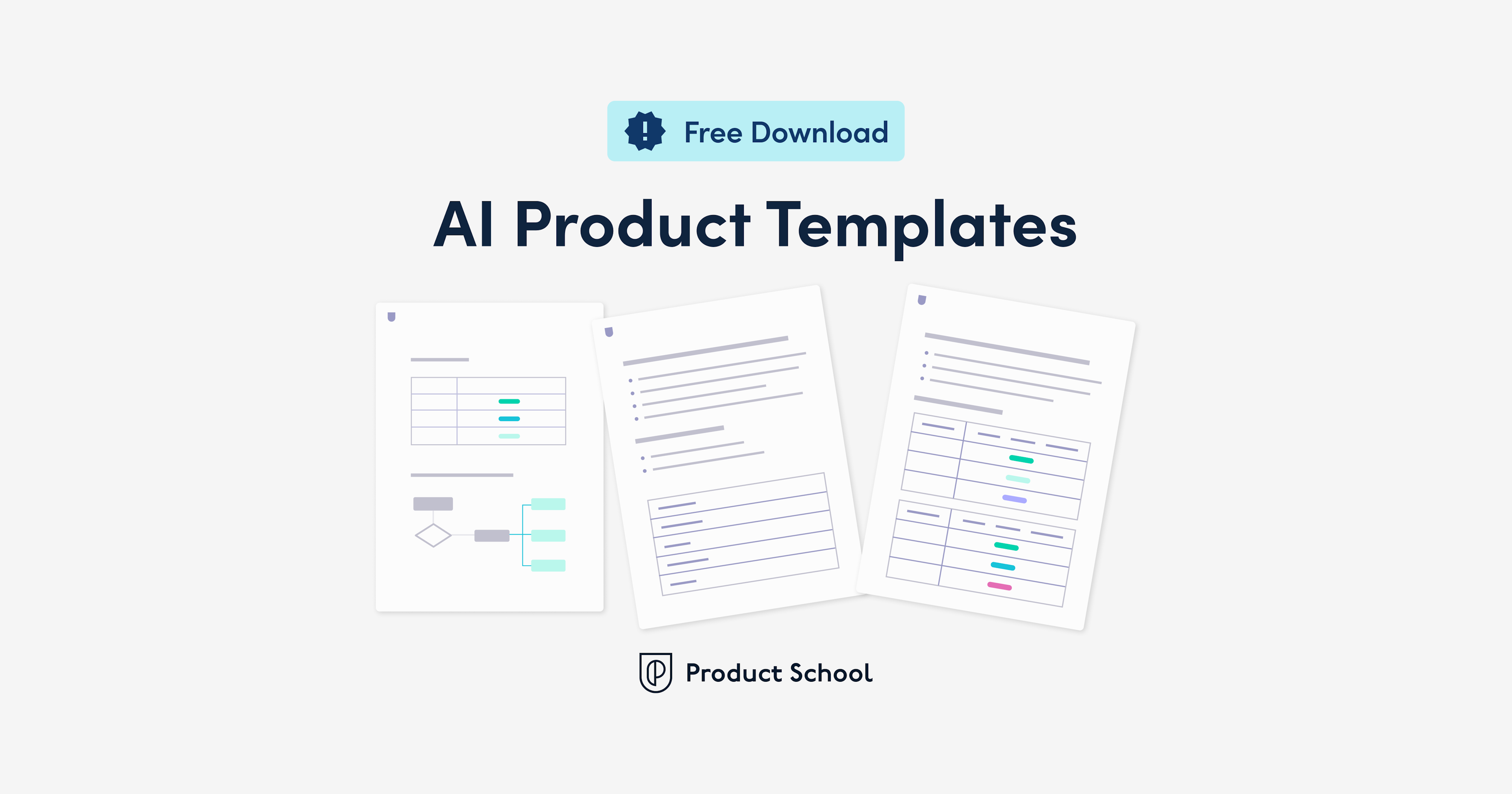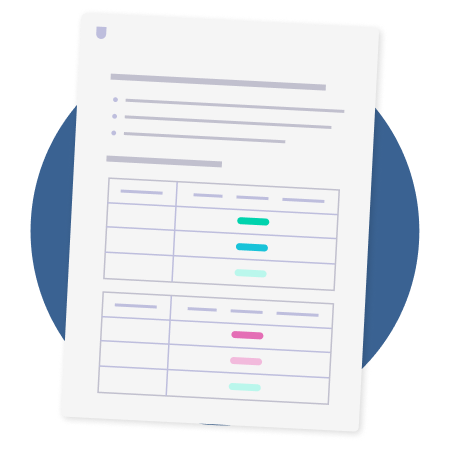Updated: April 25, 2024 - 15 min read
The role of a Product Manager is demanding. You need to develop product strategy, conduct market research, create product roadmaps, prioritize features, collaborate with cross-functional teams… Wouldn’t it be great if there were some tools to help?! In this post, we’ll explore the top AI tools for Product Managers that will not only save time and resources but also help you to create better products.
There’s a lot to cover, so if you’re pressed for time, use the table of contents above to skip to the tools you’re most interested in. There’s a universe of AI tools to explore, so let’s dive right in! Oh, and just FYI, numbers 3, 4, and 5 are FREE templates you can use to help you develop AI products.

1. ChatGPT – The Conversation-Starting AI
No list of top AI tools for Product Managers was ever going to be complete without mentioning Open AI’s Chat GPT.In addition to helping you summarize, edit, and create texts, Chat GPT can help you with a wide array of tasks.
How Chat GPT can help Product Managers:
Idea Prioritization: Use ChatGPT to brainstorm and prioritize ideas for product improvements or new features.
Data Management: ChatGPT can assist in managing and organizing product-related data by structuring data, creating databases, and generating reports or summaries. This is a real time-saver!
Launch Plans: Product Managers can collaborate with ChatGPT to outline and refine launch plans. It can assist in drafting release notes, user communications, and marketing content.
2. Google Bard – Your Conversational AI Chatbot
Imagine having an AI-powered conversational genius at your disposal as a Product Manager. Google Bard is just that. More than just an AI writing tool; it's your go-to companion for answering questions, composing diverse forms of content, and even solving complex problems.
How Google Bard can help Product Managers:
Industry Insights: Bard can provide you with up-to-date information about industry trends, competitor activities, and market developments.
Content Generation: Use Bard to quickly generate various types of content, such as reports, documentation, and project plans. Not only is this a huge time-saver, it also ensures consistent quality.
Multilingual Support: Bard's language translation capabilities are valuable for international Product Managers who need to communicate with global teams and customers
3. Chatbot Prompting Template
Tools like ChatGPT and Google Bard don’t require a technical degree, but they are much more effective when used correctly. This free template from Product School shows you how to craft precise prompts to engage effectively with natural language processing chatbots to ensure you generate quality results.
How to use Product School’s product template
Follow the template to ensure you provide the right amount of detail and clearly delegate to the chatbot.
Prompt for specific elements such as role, audience, and goal to ensure you’re getting the best response possible!
AI Prompt Template
Engage effectively with natural language processing chatbots to ensure quality results.
GET THE TEMPLATE
4. AI User Flow Template
AI product development requires a deep understanding of user needs and seamless integration of AI. This free template validated by Product School’s expert AIPC™ course creator is your guide to crafting intuitive flows that avoid bias and build trust with users. Break down a complicated process into clearly defined flows from the initial entry point to the generated output alongside real-world examples from AI products.
How to use the AI User Flow template
Identify user entry point(s)
Map out all possible user actions
Specify data inputs & generated outputs
Apply best practices
See the process applied to real-world AI products like Tinder to put the different steps in context
AI User Flow Template
Essential steps applied to real-world examples from AI product management break down a complicated process into clearly defined flows from the initial entry point to the generated output.
DOWNLOAD FOR FREE
5. AI Product Requirements Document (PRD) Template
When it comes to developing non-deterministic products, there is a steep learning curve even for experienced Product Managers. This free AI PRD Template from Product School throws you a lifeline with everything you need to align stakeholders.
How to use the AI PRD template
Write an abstract, delegate to team members, and establish objectives.
The template guides you through requirements and considerations for Large Language Models, data, prompting, and testing to ensure your AI features are built on a solid foundation.
Complete a risk assessment and check off legal requirements.
Follow the guidelines for a successful go-to-market strategy and get ready to launch!
AI PRD Template
Plan, strategize, and align stakeholders around the key requirements unique to AI products.
By sharing your email, you agree to our Privacy Policy and Terms of Service

6. Missive – Streamlined Communication for Product Teams
Communication lies at the heart of successful Product Management, where cross-functional collaboration with teams and clients is paramount. Missive, the innovative team inbox platform, offers a unified hub for email, SMS, and social media messages. But it doesn't stop there; it seamlessly integrates AI, making it a valuable ally for Product Managers.
Use Missive to supercharge:
Unified Communication: Missive offers a unified inbox for managing emails, SMS, and social media messages. This helps Product Managers streamline communication and stay organized, particularly when collaborating with cross-functional teams.
Email Automation: Missive's AI integration can automate tasks like summarizing customer emails and fixing grammar mistakes, allowing you to focus on more strategic aspects of your role.
Real-time Interaction: Real-time interaction with clients and team members ensures that everyone stays on the same page – essential for successful product development and customer support.
7. Recruitee – Your AI-Powered Recruitment Partner
For Product Managers looking to build high-performing teams, the recruitment process can be a time-consuming endeavor. Enter Recruitee. Armed with OpenAI's natural language processing capabilities, this tool can simplify your hiring efforts, from crafting compelling job descriptions to maintaining consistent candidate communication.
Use Recruitee for:
Efficient Hiring: Recruitee's AI-powered job description generation simplifies the hiring process for Product Managers. You can create compelling job postings quickly, attracting top talent to their teams.
Candidate Communication: AI-generated email templates can be used to maintain consistent and professional communication with candidates throughout the hiring process, enhancing the candidate experience.
Job Posting Templates
Get inspired by our job posting templates and attract the best talent for your new PM role.
Read now
8. Kadoa – Simplifying Data Extraction with AI
Making data-based decisions is paramount in Product. However, extracting and processing data from diverse sources can be a time-consuming and error-prone task. With Kadoa, you can transform your approach to data processing and analysis, saving time, reducing costs, and unlocking the full potential of your data-driven initiatives.
Ways Kadoa can help Product teams:
Workflow Automation: Reduce manual data entry and processing tasks, freeing up valuable time to focus on strategy, innovation, and decision-making.
Data Analysis: Gain deeper insights into product performance and customer behavior by accessing and transforming unstructured data into actionable information, facilitating data-driven decision-making.
Unlocking Unstructured Data: Leverage the true potential of unstructured data, extracting valuable information from sources like websites, PDFs, and CSVs, which might have otherwise remained untapped.
9. MixPanel – Unleashing Real-time User Behavior Insights
In a landscape where understanding user engagement and behavior patterns is paramount, Mixpanel shines. It allows businesses to gain real-time insights into how users interact with their products, identify critical patterns, and make informed choices regarding product development and marketing strategies.
How Mixpanel can help Product Managers:
Event Tracking: Mixpanel's event tracking feature is a game-changer for Product Managers and market researchers. It allows businesses to meticulously track specific events or user actions within their products. These events can be customized to align with business objectives and encompass actions like button clicks, form submissions, app installations, and more. This granular tracking facilitates the identification of user behavior patterns, providing deep insights into user needs and preferences.
User Retention Tracking: With AI-driven user retention tracking, Mixpanel offers a comprehensive view of how frequently users return to a product. This capability provides invaluable insights into user loyalty and opportunities to enhance retention. By analyzing retention rates over time, businesses can make well-informed decisions to improve user satisfaction, engagement, and long-term relationships.
A/B Testing: Mixpanel's A/B testing capabilities empower businesses to conduct experiments with different variations of their products or user experiences. This feature is a treasure trove for Product Marketers, enabling them to assess the impact of various marketing strategies, user interface modifications, or product feature changes on user behavior, conversion rates, and other vital metrics.
10. Amplitude – Your AI-Powered Analytics Companion
To stay ahead in the competitive world of Product Management, you’ll need to leverage data analytics. Enter Amplitude, an AI-powered tool that has been at the forefront of utilizing AI technology long before the AI hype of 2022.
Amplitude's AI-powered toolkit equips Product Managers with the means to navigate the data landscape effectively, transforming raw data into actionable insights and enabling data-driven decision-making.
How Amplitude can help Product Managers:
Data Assistant: Amplitude's Data Assistant is a crucial tool for Product Managers who understand the importance of high-quality data. It helps measure and qualify data, ensuring that product decisions are based on accurate and reliable information.
Ask Amplitude: One of the challenges Product Managers often face is translating business questions into actionable insights. Ask Amplitude serves as the bridge between these questions and insights, enabling you to ask complex queries and receive meaningful data-driven answers. This tool streamlines the process of extracting actionable insights from data, saving time and effort.
Amplitude Experiment: Experimentation is a vital aspect of product development. Amplitude Experiment simplifies the entire process, from identifying hypotheses to designing experiments, creating variants, deploying changes, and assessing results. This end-to-end solution empowers Product Managers to run experiments efficiently, optimize product features, and drive continuous improvement.
How to Leverage AI in Product Analytics: The Ultimate Guide
Learn how you can use AI product analytics to improve business and product outcomes, sift through massive datasets, and make better decisions.
Read Now
11. Zeda.io – AI-Powered Product Discovery and Strategy
Zeda.io emerges as one of the most formidable AI tools specifically tailored to address the multifaceted challenges faced by Product Managers, helping you to stay ahead and drive innovation. This AI-powered product discovery and strategy tool is designed to streamline Product Management processes and empower Product Managers to create products that meet business objectives and resonate with customer needs and preferences.
How Zeda.io AI can help Product Managers:
Automated Tags and Categorized Inboxes: AI technology within Zeda.io generates automated tags and categorizes inboxes, simplifying the organization and management of collected feedback. This organization allows you to efficiently prioritize and address customer concerns and product improvement opportunities.
Product Intelligence Analysis: Zeda.io enables you to leverage AI technology for in-depth product intelligence analysis. This includes segmenting user cohorts and examining customer attributes to identify trends and patterns. By understanding user behavior and preferences, you can make informed decisions about feature prioritization and development.
Document Module with AI: Zeda.io's document module is powered by AI technology, simplifying the creation of essential documents. It includes built-in prompts to guide you in generating documents such as Product Requirement Documents (PRD) and release notes quickly and efficiently. Custom prompts can also be created to tailor document generation to specific needs.
A Guide To Innovation: How To Become An AI Product Manager
Unlock the secrets of merging AI with Product Management to innovate and address real human needs, dive into strategies for AI integration, and learn how to transform data into insights.
Read Now
12. ProductBoard – Mastering Customer-Centric Product Management
Product Managers face the monumental task of understanding customer needs, prioritizing features, and rallying stakeholders around a coherent product roadmap. In this landscape, ProductBoard emerges as an invaluable tool, simplifying and streamlining the complex process of collecting feedback, making informed decisions, and effectively communicating the product vision.
How ProductBoard can help Product Teams:
Frame AI Integration: ProductBoard's integration with Frame.ai is a game-changer for Customer Experience (CX) leaders. It leverages AI to analyze customer conversations, providing insights into customer sentiments, preferences, and pain points. The integration intelligently categorizes incoming feedback, making it easier for product teams to understand the most pressing issues and prioritize improvements.
Visual Product Roadmaps: Communication is key when it comes to Product Management. ProductBoard excels in this aspect by enabling product teams to create visually appealing and easy-to-understand product roadmaps. These roadmaps help align stakeholders around the product vision, ensuring everyone is on the same page regarding the product's direction and objectives.
Distinct Feedback Channels: ProductBoard enables the setup of distinct feedback channels, allowing for targeted collection and analysis of user input. This segmentation ensures that product teams can focus on specific areas of interest, whether it's feedback related to a particular feature, customer segment, or market trend.
13. Peak.ai – Elevating Product Inventory and Pricing
Peak.ai isn’t your typical AI platform—it's a powerhouse dedicated to optimizing product inventory, pricing strategies, and customer personalization. While it might not grab the spotlight like flashy generative AI, it brings immense value to businesses by enhancing efficiencies across their value chain.
Ways Peak.ai can help Product Managers:
Efficiency Improvement: Peak.ai's "boring" AI isn't dull at all; it's a game-changer in improving operational efficiencies. Leverage its capabilities to streamline decision-making, allocate resources optimally, and reduce the cost of serving customers.
Personalization: Personalized customer experiences are a hallmark of successful Product Management. Peak.ai empowers Product Managers to deliver personalized omnichannel experiences, increasing customer lifetime value and loyalty.
Pricing Optimization: Set optimal prices for products throughout the product lifecycle with Peak.ai's pricing optimization capabilities. This ensures that products are competitively priced and contribute to revenue growth.
AI-Empowered Work with Lane Shackleton, Coda’s CPO
Dive into the future of AI-empowered work and learn how to leverage cutting-edge technology to add real value to your products.
Read Now
14. Kindly.ai – Elevate Customer Communications with AI
Kindly.ai steps into the arena of customer support and sales, aiming to elevate customer communications through virtual shopping assistants, AI chatbots, and conversion optimization tools. Powered by advanced machine learning algorithms, Kindly.ai enhances user experiences and empowers support and sales teams.
Ways Kindly.ai can help Product Managers:
Integration with Bug Tracking Systems: Kindly.ai can integrate with bug tracking and feature request management systems commonly used by product teams. When users report issues or request new features, the chatbot can automatically create or update tickets in these systems, ensuring that nothing gets lost in the process.
Feedback Summarization: Kindly.ai can summarize and aggregate user feedback over time. This allows you to access concise reports highlighting the most common bug reports and feature requests, making it easier to prioritize and address them.
Conversion Optimization: Use Kindly.ai's conversion optimization tools to fine-tune the customer journey, increasing conversion rates and revenue generation. These tools offer valuable insights into customer behavior and preferences
15. Notion – The Ultimate Tool for Organization
Effective organization is the cornerstone of efficient Product Management. That’s where Notion comes in.
Notion AI can assist Product Managers with:
Document Organization: Notion's AI capabilities help you to organize meeting notes, and instantly generate action items, and other documentation more efficiently. It can also suggest improvements and generate action items automatically.
Spelling and Grammar: AI-powered proofreading ensures that written content is error-free and polished, improving the quality of communication and documentation.
Text Summarization: Notion's text summarization feature is beneficial for condensing lengthy documents, reports, or meeting notes into concise summaries, saving time for you and key stakeholders.
The Future of AI in Product
How will AI shape the world of Product? Find out in this blog post.
Read Now
16. ClickUp – AI-Powered Project Management
ClickUp empowers Product Managers by automating repetitive tasks, enhancing communication, and promoting creative thinking. Its AI-driven features are designed to improve efficiency, reduce manual work, and ultimately contribute to creating better products.
Ways ClickUp can help Product Managers:
AI Content Ideas: Need inspiration for your product's content strategy? ClickUp's AI can generate creative content ideas based on trends, industry insights, and user preferences, helping you to plan engaging content.
Feature Name Suggestions: Naming features and functionalities is a crucial aspect of Product Management. ClickUp AI can propose relevant and appealing feature names, simplifying the decision-making process.
Survey Generation: When gathering user feedback is essential, ClickUp can assist in crafting surveys tailored to your product's needs, allowing you to collect valuable insights efficiently.
17. Tl;dv – Streamlined Meeting Summaries with AI
Picture a tool that can capture, transcribe, and summarize all your important meetings within seconds. That's precisely what tl;dv brings to the table for Product Managers. By automating the tedious task of note-taking during calls, this AI-powered meeting recorder allows you to focus on active participation and extracting valuable insights.
Use Tl;dv for:
Meeting Efficiency: tl;dv streamlines the process of capturing meeting content, generating instant transcripts and summaries of your calls. This helps in retaining important information and action items.
Customizable Summaries: Tailor AI-generated summaries to focus on specific aspects of meetings, such as UX feedback or bug mentions. This ensures that relevant insights are captured and shared with the team.
How to Become a Product Manager for AI/ML Products
Discover the skills you need to become an AI/ Machine Learning Product Manager.
Read more
18. H20.ai – The One for AI Product Managers
A transformative force in the realm of AI and machine learning, H2O.ai if one of the most potent AI tools for Product Managers when it comes to automating and streamlining complex data tasks.
With a primary focus on predictive modeling and data-driven insights, H2O.ai is at the forefront of enabling data-powered decision-making. Whether it's predictive modeling, classification analysis, or understanding complex customer behavior, H2O.ai offers the tools and scalability needed for data-driven success.
How H2O.AI can help Organizations:
Advanced Machine Learning Algorithms: H2O.ai boasts a wide array of advanced machine learning algorithms, providing users with the tools to create predictive models, classification algorithms, and clustering analyses. These algorithms enable you to uncover valuable insights, identify trends, and make data-driven decisions that drive success across various domains, from customer behavior analysis to market research.
AutoML Capabilities: H2O.ai's AutoML functionality simplifies the process of model selection and hyperparameter tuning. This automation allows users, regardless of their expertise level, to swiftly generate accurate and effective models. By automating these complex tasks, organizations can save time and resources while maintaining the integrity of their analyses.
Integration and Deployment: H2O.ai seamlessly integrates with popular data analytics and visualization tools, streamlining the incorporation of its insights into existing workflows. Furthermore, it supports model deployment across various environments, allowing organizations to apply data-driven insights in real-world scenarios, from optimizing business operations to enhancing customer experiences.
Updated: April 25, 2024



